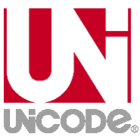Unicode: Difference between revisions
| Line 13: | Line 13: | ||
*Alex Taylor: [[OS/2 and Multilingual Character Sets - Part 2]] | *Alex Taylor: [[OS/2 and Multilingual Character Sets - Part 2]] | ||
* [[Universal Language Support Functions]] | * [[Universal Language Support Functions]] | ||
* [[ | * [[Universal Language Support]] | ||
==Links== | ==Links== | ||
Revision as of 14:29, 13 August 2017

Unicode is an industry standard for the encoding and representing of text governed by the Unicode Consortium. It is an attempt to give computers a uniform way of handling text but traditionally text on computer systems has done by proprietary encodings and frequently has only been capable of representing a limited subset of the world's writing systems, due to not only hardware and software limitations but also to commercial interests and cultural bias.
16-bit Unicode compatibility was added to OS/2 in 1996/97, it is included as standard with OS/2 Warp Server for e-business and with later fixpaks for Warp 3 and Warp 4.
- Controversies
Unicode has always been a bit controversial, the original system was limited to a 16-bit character set which is not enough to represent even the most popular writing systems in the world, but pictographic systems such as Kanji have thousands of characters unlike character sets that represent sounds, which usually only have tens or low hundreds of characters. Early versions of Unicode therefore had some odd omissions, characters used in Japanese personal and place names for instance still are not included and even though Unicode 2.0 increased the size of the character space to a theoretical 32 bits (actually 21 bits), the use of languages like Japanese and other common Asian languages is still complicated and is the encoding is still frequently being performed with locally developed alternatives. Some of the later developments such as UTF-8 also have problematic aspects both conceptually and in practice.
What made Unicode even more controversial was that a more flexible open source system called TRON had already existed for a number of years before work on Unicode commenced, but TRON in addition to being more flexible is actually easier to implement and can be lighter on computer resources, a number of Japanese companies had implemented and shipped TRON on embedded 8 bit systems during the 80's. The problem was that the regulation of TRON was handled by a Japanese consortium rather than by an American one, and during the Japanese/USA trade negotiations of 1986, the USA government actually demanded that TRON source code would not be distributed outside of Japan and technical documentation not be distributed in a translation to a western language.
Articles
- Alex Taylor: OS/2 and Multilingual Character Sets - Part 1
- Alex Taylor: OS/2 and Multilingual Character Sets - Part 2
- Universal Language Support Functions
- Universal Language Support
Links
- OS/2 specific information
- OS/2 Unicode API - Alexander Taylor's OS/2 Unicode API page
- Software
- Jonathan de Boyne Pollard: The 32-bit Unicode Console API for OS/2
- Ken Borgendale: OS/2 Codepage and Keyboard Display Tools